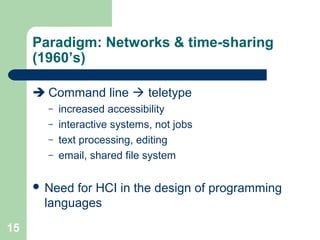Lcture 1
- 1. Human Computer Interaction Khalid Mahmood (MSCS) k.mah.khan@live.com
- 2. Outline Course Info & Syllabus Course Overview Introductions HCI Overview A brief history 2
- 3. Course Aims Consciousness raising – Make you aware of HCI issues Design critic – Question bad HCI design - of existing or proposed Learn Design Process – Software interfaces and beyond Improve your HCI design & evaluation skills – Go forth and do good work! 3
- 4. Course Overview Requirements Gathering – How do you know what to build? – Human abilities Design – How do you build the best UI you can? Evaluation – How do you make sure people can use it? Also cognitive and contextual models, interface paradigms, design guidelines, web and visual design, and advanced topics4
- 5. HCI The interaction and interface between a human and a computer performing a task – Tasks might be work, play, learning, communicating, etc. etc. – Write a document, calculate monthly budget, learn about places to live in Charlotte, drive home… …not just desktop computers! 5
- 6. Why do we care? Computers (in one way or another) now affect every person in our society Tonight - count how many in your home/apt/room We are surrounded by unusable and ineffective systems! Its not the user’s fault!! Product success may depend on ease of use, not necessarily power You will likely create an interface for someone at some point – Even if its just your personal web page 6
- 7. Goals of HCI Allow users to carry out tasks – Safely – Effectively – Efficiently – Enjoyably 7
- 8. Usability Combination of – Ease of learning – High speed of user task performance – Low user error rate – Subjective user satisfaction – User retention over time 8
- 9. Design Evaluation Both subjective and objective metrics Some things we can measure – Time to perform a task – Improvement of performance over time – Rate of errors by user – Retention over time – Subjective satisfaction 9
- 10. UI Design / Develop Process User-Centered Design – Analyze user’s goals & tasks – Create design alternatives – Evaluate options – Implement prototype – Test – Refine – IMPLEMENT 10
- 11. Know Thy Users! Physical & cognitive abilities (& special needs) Personality & culture Knowledge & skills Motivation Two Fatal Mistakes: – Assume all users are alike – Assume all users are like the designer 11
- 12. Design is HARD! “It is easy to make things hard. It is hard to make things easy.” – Al Chapanis, 1982 Its more difficult than you think Real world constraints make this even harder 12
- 13. The past… Time UserProductivity Batch Command Line WIMP (Windows) 1940s – 1950s 1980s - Present1960s – 1970s ? ? 13
- 14. Batch processing Computer had one task, performed sequentially No “interaction” between operator and computer after starting the run Punch cards, tapes for input Serial operations 14
- 15. Paradigm: Networks & time-sharing (1960’s) Command line teletype – increased accessibility – interactive systems, not jobs – text processing, editing – email, shared file system Need for HCI in the design of programming languages 15
- 16. The Ubiquitous Glass Teletype Source: http://www.columbia.edu/acis/history/vt100.html 24 x 80 characters Up to 19,200 bps (Wow - was big stuff!) 16
- 17. Paradigm: Personal Computer Small, powerful machine dedicated to an individual Importance of networks and time- sharing Also: – Laser printer (1971, Gary Starkweather) – Ethernet (1973, Bob Metcalfe) 17
- 18. Paradigm: WIMP / GUI Windows, Icons, Menus, Pointers Graphical User Interface Multitasking – can do several things simultaneously Has become the familiar GUI interface Computer as a “dialogue partner” Xerox Alto, Star; early Apples 18
- 19. Xerox Star - 1981 First commercial PC designed for “business professionals” – desktop metaphor, pointing, WYSIWYG, high degree of consistency and simplicity First system based on usability engineering – Paper prototyping and analysis – Usability testing and iterative refinement 19
- 20. Apple Macintosh - 1984 Aggressive pricing - $2500 Not trailblazer Good interface guidelines 3rd party applications High quality graphics and laser printer “The computer for the rest of us” 20
- 21. Paradigm: WWW Hypertext around since the 1960’s… Two new components – URL – Browser Tim Brenners-Lee did both – 1991 first text-based browser Marc Andreesen created Mosaic (first graphic browser, 1993) 21
- 24. Course ReCap To make you notice interfaces, good and bad – You’ll never look at doors the same way again To help you realize no one gets an interface right on the first try – Yes, even the experts – Design is HARD To teach you tools and techniques to help you iteratively improve your designs – Because you can eventually get it right 24
Editor's Notes
- #17: Construction: Monitor + detachable keyboard Display: 24x80 or 14x132 character cells, optional 24x132 Character matrix: 7x9 with descenders Screen size: 12" diagonal (8" x 4.5" active display) Character set: Complete US ASCII (128 codes) Keys: 65 keys in ANSI X4.14-1971 typewriter layout http://www.columbia.edu/acis/history/vt100.html Auxiliary keypad: 18 keys (digits, arrows, function keys) Visual indicators: 7 LEDs Interface: RS-232/V.24, optional 20mA Current Loop Flow control: Xon/Xoff Communication Speeds: 75,110,150,300,600,1200,2400,4800,9600,19200 bps Dimensions: 14.5"x18"14.25" (monitor), 3.5"x18"x8" (keyboard) Minimum table depth: 20.25" Weight: 41 pounds
- #20: But it was a flop – too expensive, closed architecture, no spreadsheet























